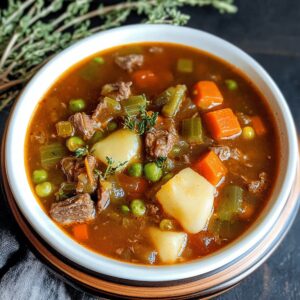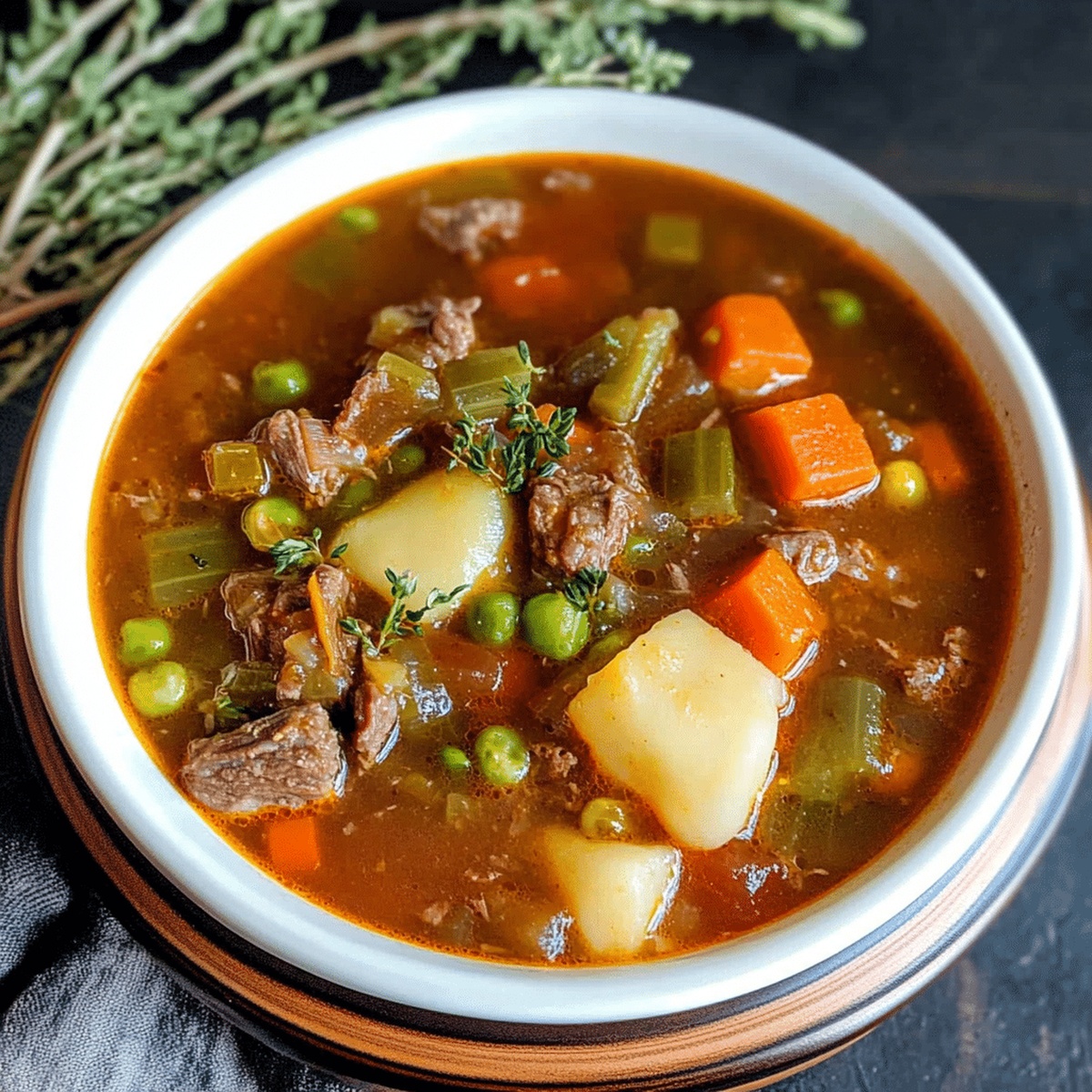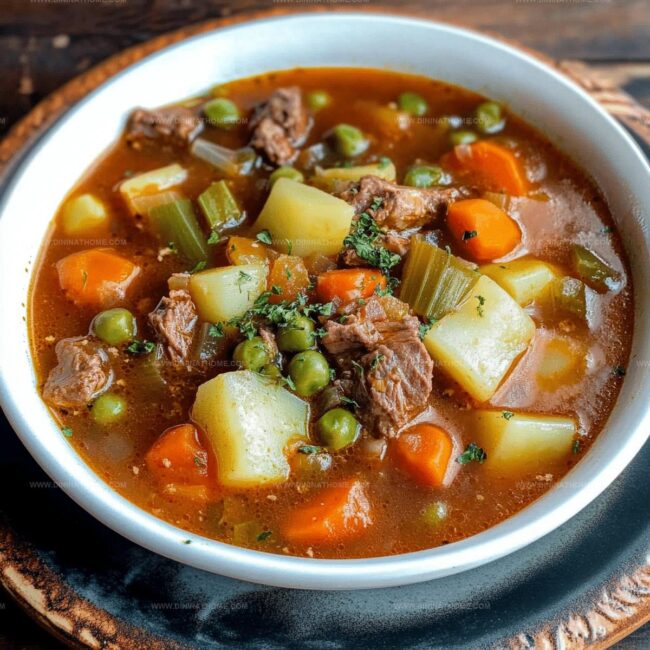Grandma’s Cozy Old-fashioned Vegetable Beef Soup Recipe
Memories of grandma’s kitchen swirl around this hearty old-fashioned vegetable beef soup that whispers comfort.
Warm aromas dance through my childhood home, reminding me of slow-cooked goodness.
Tender chunks of beef nestle alongside colorful vegetables in a rich, savory broth.
Rustic and simple ingredients blend into a bowl of pure nostalgia.
Cold winter nights feel instantly warmer with each spoonful of this classic soup.
Generations have cherished this recipe, passing down its soul-warming magic from one kitchen to another.
Vegetable Beef Soup With Old-Fashioned Heartiness
Parts In An Old-Fashioned Veggie Beef Soup
Main Protein:Fresh Vegetables:Frozen Vegetables:Liquid and Seasoning Base:Old-Fashioned Vegetable Beef Soup Prep
Step 1: Prepare the Meat
Carefully trim excess fat from the pot roast and slice into bite-sized chunks.
The smaller pieces will help the meat cook evenly and become super tender.
Step 2: Warm the Broth
Pour beef broth into a large pot and heat over medium temperature.
This creates the flavorful base for your hearty soup.
Step 3: Add Initial Vegetables
Toss in the following vegetables:Step 4: Create Liquid Base
Stir in tomato soup and fill the empty soup can with water.
Mix everything thoroughly to create a rich, smooth liquid foundation for the soup.
Step 5: Incorporate Meat
Gently add pot roast pieces into the bubbling liquid.
Lower the heat to allow slow, gentle cooking.
Step 6: Simmer and Tenderize
Cover the pot and let the soup simmer slowly for 2-3 hours.
This low and slow method ensures the meat becomes melt-in-your-mouth tender.
Step 7: Add Final Vegetables
About 30 minutes before serving, drop in:Step 8: Season and Taste
Sprinkle salt and pepper to enhance the overall flavor.
Taste and adjust seasonings as needed.
Step 9: Serve and Enjoy
Ladle the steaming soup into bowls.
Optional: Garnish with fresh chopped herbs for an extra burst of freshness.
Vegetable Beef Soup Helpful Tricks
Vegetable Beef Soup Classic Leftover Storage Plan
Pairs Well with Old-fashioned Vegetable Beef Soup
Vegetable Beef Soup Throwbacks
FAQs
Yes, you can substitute chuck roast, stew meat, or even ground beef. Each cut will provide a slightly different texture and flavor to the soup.
While trimming excess fat helps reduce greasiness, leaving a little fat can enhance the soup’s richness and flavor. Just remove large chunks of fat for better taste.
Absolutely! Transfer all ingredients to a slow cooker and cook on low for 6-8 hours or on high for 4-5 hours. The long, slow cooking helps tenderize the meat and develop deep flavors.
Consider adding additional vegetables like celery or parsnips, or include a handful of barley or small pasta to increase the soup’s heartiness and nutritional value.
Print
Old-fashioned Vegetable Beef Soup Recipe
- Total Time: 3 hours 20 minutes
- Yield: 6 1x
Description
Hearty old-fashioned vegetable beef soup promises comfort in every spoonful, delivering a classic American kitchen staple. Rich beef, tender vegetables, and aromatic herbs meld together, creating a soul-warming meal that welcomes you home with its deeply satisfying flavors.
Ingredients
Protein:
- 1 pot roast (about 2 pounds / 907 grams)
Vegetables:
- 2 russet potatoes, chopped
- 4 large carrots, chopped
- 1 bag frozen seasoning blend (or chopped onions)
- 1 bag frozen peas
- 1 bag frozen green beans
- 1 bag frozen corn
Liquid and Seasonings:
- 1 (32 ounces / 946 milliliters) container beef broth
- 2 (10.75 ounces / 305 grams) cans tomato soup
- 1 can filled with water
- Salt, to taste
- Pepper, to taste
Instructions
- Carefully trim excess fat from the pot roast and slice into uniform, bite-sized cubes for even cooking and tender texture.
- Position a large cooking vessel over medium heat and gently warm the beef broth to create a flavorful liquid base.
- Introduce diced potatoes, julienned carrots, and aromatic seasoning blend into the simmering broth, distributing ingredients evenly.
- Pour in tomato soup and corresponding water volume, whisking to create a harmonious and rich liquid consistency.
- Allow the mixture to reach a gentle simmer, then carefully nestle the prepared pot roast pieces throughout the liquid.
- Cover the pot with a tight-fitting lid and reduce heat, allowing the soup to slowly develop flavors and tenderize the meat over 2-3 hours.
- During the final 30 minutes of cooking, incorporate vibrant frozen vegetables – sweet peas, crisp green beans, and golden corn kernels.
- Delicately season with salt and pepper, tasting and adjusting the flavor profile to personal preference.
- Ladle the hearty soup into warm bowls, optionally garnishing with freshly chopped herbs for an elegant presentation.
Notes
- Trim meat carefully to reduce excess fat and ensure tender, flavorful bites during cooking.
- Select chuck roast or stew meat for maximum tenderness and rich beef flavor in the soup.
- Slow cooking transforms tough meat cuts into meltingly soft, delicious protein perfect for hearty soup.
- Experiment with low-sodium broth or vegetable broth for lighter, healthier version without compromising taste.
- Prep Time: 20 minutes
- Cook Time: 3 hours
- Category: Dinner, Lunch, Appetizer
- Method: Slow Cooking
- Cuisine: American
Nutrition
- Serving Size: 6
- Calories: 320
- Sugar: 6 g
- Sodium: 800 mg
- Fat: 12 g
- Saturated Fat: 4 g
- Unsaturated Fat: 8 g
- Trans Fat: 0 g
- Carbohydrates: 40 g
- Fiber: 7 g
- Protein: 20 g
- Cholesterol: 70 mg





Emily Harper
Nutrition Consultant & Recipe Analyst
Expertise
Healthy Recipe Modification, Nutritional Analysis & Meal Planning, Global Cuisine & Dietary Adaptations
Education
School: French Pastry School, Chicago, IL
Program: L’Art de la Pâtisserie
Focus: Intensive training in traditional French pastry techniques, baking theory, and confectionery arts.
Emily’s journey started in a pastry kitchen but took a detour into the world of health and flavor science.
Graduating from the French Pastry School and studying nutrition opened her eyes to a new mission: making healthy food taste like something you’d actually crave.
At Dining At Home, Emily’s the go-to for smart, feel-good recipes that don’t trade flavor for nutrition.
She’s all about adding a fresh spin on old favorites and finding small ways to make everyday meals a little brighter.
Outside of the kitchen, Emily is most at home walking forest trails, testing plant-based recipes, or sharing a picnic under a wide-open sky.